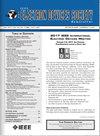Vertical FET Optimization at Angstrom Nodes: A Comparative Study With Horizontal FET
IF 2.4
3区 工程技术
Q3 ENGINEERING, ELECTRICAL & ELECTRONIC
引用次数: 0
Abstract
For the first time, this study presents two novel vertical FET (VFET) structures and conducts a quantitative analysis to assess the competitiveness of VFET in comparison to two types of horizontal FET (HFET) which are nanosheet FET (NSFET) and forksheet FET (FSFET) targeting Angstrom nodes. The conventional VFET (VFETCON) design exhibits a larger footprint than FSFET, delivering an inferior performance even when optimized for gate length. By contrast, the novel fork-shaped channel VFET (VFETFS) demonstrates a 10.5% reduction in the effective area compared to VFETCON, achieving a smaller footprint than FSFET with a large contact poly pitch (CPP). Additionally,埃节点垂直场效应管优化:与水平场效应管的比较研究
本研究首次提出了两种新型垂直场效应管(VFET)结构,并进行了定量分析,以评估VFET与两种针对埃节点的水平场效应管(HFET),即纳米片FET (NSFET)和叉片FET (ffet)的竞争力。传统的ffet (VFETCON)设计比ffet具有更大的占地面积,即使对栅极长度进行了优化,其性能也较差。相比之下,新型叉形通道VFET (VFETFS)的有效面积比VFETCON减少了10.5%,实现了比具有大接触聚节距(CPP)的ffet更小的占地面积。此外,$\ mathm {VFET_{FS}}$比$\ mathm {VFET_{CON}}$提供更强的性能,因为电容减少了。然而,$\mathrm {VFET_{FS}}$的有效面积更大,驱动电流(Ion)明显低于CPP较小的fset。扩大硅化面积的策略通过降低寄生电阻有效地改善了$\ mathm {I_{on}}$,使NFET $\ mathm {VFET_{FS}}$优于fset。然而,对于fet而言,由于在非应力条件下性能下降的影响更大,采用扩大硅化面积的$\ mathm {VFET_{FS}}$表现出比fset更低的性能。二次器件结构$\ mathm {VFET_{FS}}$ with backside contact (VFETBSC)进一步减小了占用空间,显著降低了寄生RC,当BSC面积较大时,散热效果良好。$\mathrm {VFET_{BSC}}$需要比fset更小的有效面积,42 nm CPP,其N/ ffet的平均性能超过fset。
本文章由计算机程序翻译,如有差异,请以英文原文为准。
求助全文
约1分钟内获得全文
求助全文
来源期刊

IEEE Journal of the Electron Devices Society
Biochemistry, Genetics and Molecular Biology-Biotechnology
CiteScore
5.20
自引率
4.30%
发文量
124
审稿时长
9 weeks
期刊介绍:
The IEEE Journal of the Electron Devices Society (J-EDS) is an open-access, fully electronic scientific journal publishing papers ranging from fundamental to applied research that are scientifically rigorous and relevant to electron devices. The J-EDS publishes original and significant contributions relating to the theory, modelling, design, performance, and reliability of electron and ion integrated circuit devices and interconnects, involving insulators, metals, organic materials, micro-plasmas, semiconductors, quantum-effect structures, vacuum devices, and emerging materials with applications in bioelectronics, biomedical electronics, computation, communications, displays, microelectromechanics, imaging, micro-actuators, nanodevices, optoelectronics, photovoltaics, power IC''s, and micro-sensors. Tutorial and review papers on these subjects are, also, published. And, occasionally special issues with a collection of papers on particular areas in more depth and breadth are, also, published. J-EDS publishes all papers that are judged to be technically valid and original.
 求助内容:
求助内容: 应助结果提醒方式:
应助结果提醒方式:


